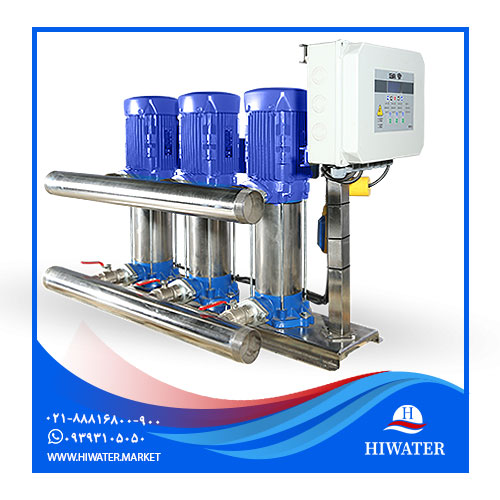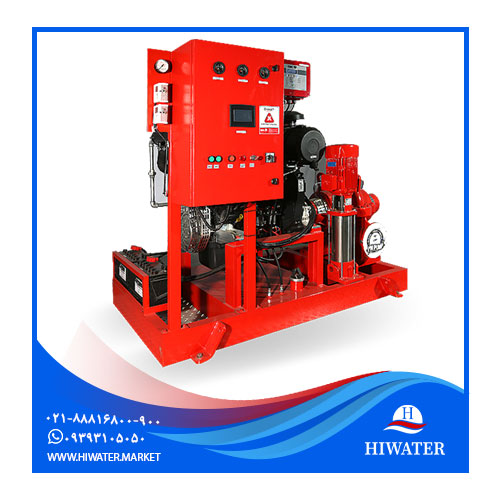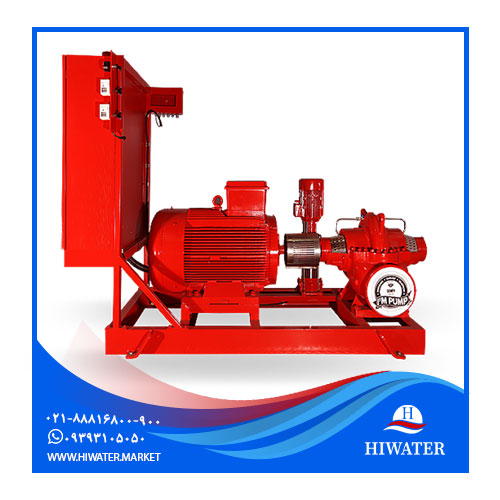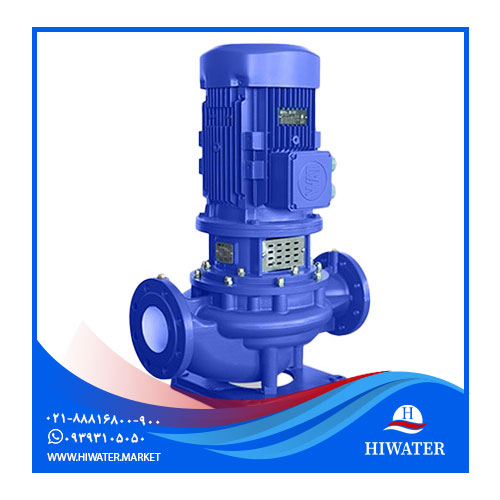Prices of Sampa Circulator Pumps
Prices of Sampa Circulator Pumps
Prices of Circulator Pumps
Sampa Industrial Circulator Water Pump
The Sampa industrial circulator water pump is one of several types of pumps, such as the Wilo circulator pump. The brand offers a variety of pumps, including agricultural water pumps, circulator pumps, and domestic water pumps.
Hiwater is the exclusive distributor of Sampa pumps in Iran. For purchasing this type of pump, you can call the contact numbers or visit the store directly to confirm the authenticity and quality of the product.
What is an Industrial Water Pump?
As its name suggests, this type of pump is designed for use in industrial settings, with applications in water purification plants, agricultural projects, factories, and more.
To our knowledge, large-scale projects require pumps that can move large quantities of water over significant distances. Therefore, the pumps used in these projects are designed with higher capacity and power.
These pumps are classified into various categories based on their operation, including positive displacement pumps, reciprocating pumps, and centrifugal pumps. Therefore, this wide range of options means industrial water pumps can cover a variety of areas.
One of the key characteristics of industrial pumps is the exceptional build quality of water pumps and their components because due to the demanding operating conditions these pumps face, they are designed to possess high resistance and strength, enabling them to perform efficiently. As a result of these features, when used correctly, these industrial water pumps typically demonstrate a remarkably long operational lifespan.
What is a Circulator Pump?
A circulator pump consists of two main components: the pump and the electric motor. The term “circulate” refers to the movement of fluid within a system, which the circulator pump performs. The function of the circulator pump is to move fluid around a closed-loop system. This type of pump, like the Shimge pump, is commonly used in heating systems.
Features of the Sampa Circulator Pump
These pumps have optimized energy consumption.
They are easy to install and operate, especially the inline version.
Compared to other pumps, they operate with significantly lower noise levels.
They are capable of continuous operation.
Their maintenance and repair are cost-effective.
A variety of models and sizes are available, allowing users to choose the most appropriate option for their needs.
They come in single-phase and three-phase models.
These pumps can function in extremely high temperatures without breaking down.
Components of an Industrial Water Pump
Body: The body is the outermost part of the circulator pump, comprising all its internal components. It is typically made from cast iron or stainless steel.
Coupling: This component is used in both inline and ground circulator pumps. Its role is to connect the pump shaft to the electric motor. Couplings are available in two types: rubber and spring. Ground pumps use rubber couplings, while inline pumps use spring couplings.
Ball Bearing: Ball bearings protect the shaft from various forces in such a way that if the bearing is damaged or missing, the shaft will be broken down, leading to the malfunctioning of the entire pump.
Discharge Port: The fluid exits the pump through this port and enters the piping system.
Gasket: This component prevents water from leaking into the bearings.
Electric Motor: The motor in the circulator pump is an asynchronous squirrel cage type. Its function is to convert electrical energy into kinetic energy. The motor is the most crucial part of the pump since the performance of all other components depends on it. A higher-quality motor ensures smoother operation. These motors come in both single-phase and three-phase options, with speeds ranging from 1,500 to 3,000 rpm.
Suction Port: This is the part where the fluid enters the pump.
Shaft: The impeller of the pump is installed on this component in such a way that electrical energy is first transmitted from the electric motor to this part, and then transferred to the impeller. Typically, the shaft in circulator pumps is made from stainless steel.
Adjustment Screw: This screw is located at the front of the circulator pump and is used for maintenance. In fact, it serves to monitor and check the motor’s functionality, air bleeding, and other functions.
Impeller: The impeller’s primary role is to increase the flow speed of the water passing through the pump. It is in direct contact with the water, so it must be durable and resistant to corrosion and rust. Therefore, impellers are usually made from highly resistant metals such as stainless steel, cast iron, or aluminum, and are designed with a centrifugal mechanism. The higher the durability of the impeller, the longer the pump’s lifespan will be. Additionally, the head and flow rate of the circulator pump are directly related to the diameter of the impeller.
Bearing: This part is responsible for keeping the pump shaft level. It is usually made of cast iron.
How the Circulator Pump Works:
Now that you are familiar with the components of a circulator pump, we explain its function to help you better understand the role of each part.
When the circulator pump is used in a water system, electrical energy enters the pump’s electric motor and then passes through to the shaft and impeller. As electrical energy reaches these two parts, the impeller blades begin to spin, drawing water from the suction inlet into the pump and the impeller chamber. As the impeller rotates, electrical energy is converted into kinetic energy, which is transferred to the water, causing it to reach the impeller’s edges. With the increased kinetic energy, the water exits the impeller at high velocity by centrifugal force. When the water exits the impeller, it strikes the pump’s walls, converting kinetic energy into pressure. Finally, the pressurized and high-speed water exits through the discharge outlet of the pump and discharges into the pipes.
Types of Circulator Pumps:
Circulator pumps come in different types based on motor speed, body material, impeller material, size, application, and other factors. We examine a few of these types as follows.
In general, circulator pumps can be divided into two categories: inline and ground-mounted.
Inline Circulator pump
This type of pump is a directly coupled electro-pump. Circulator pumps with lower power are commonly called inline circulator pumps. These pumps are installed in the circuit, and their inlet and outlet are aligned along the same axis. The pump body is generally made from cast iron, stainless steel, or iron, while the impeller is made from polyamide, which is resistant to rust and corrosion. This type of pump is used in heating and cooling systems.
Inline circulator pumps are produced in two types: the first type uses a coupling and an intermediary, while the second type is direct and without any intermediary.
Ground Circulator pump
Pumps with high power are known as ground circulator pumps. These pumps are specifically designed to function effectively when the required pressure and performance exceed the capacity of in-line circulator pumps. Due to their heavy weight and the vibrations they generate, they are placed on the ground, with their inlet and outlet perpendicular to one another. The body of these pumps is typically made of cast iron, while the impeller is manufactured from either brass or cast iron. Moreover, the electric motor in these pumps is designed for continuous operation.
Ground circulator pumps are generally divided into two broad categories:
First Category: In this category, the electric motor and pump are connected via an intermediary component.
Second Category: In this category, the pump and electric motor are connected through a coupling, a chassis, and a coupling mechanism.
Difference Between Inline Circulator Pumps and Ground Circulator Pumps:
Inline pumps are used to maintain flow rates but circulator pumps are designed to provide flow rates and head.
Ground pumps withstand lower temperatures than inline pumps.
Inline pumps are ideal for use in domestic hot water circuits, while ground pumps are ideal for heating system circuits.
Inline pumps occupy less space compared to ground pumps.
Installing a ground pump in a system requires additional fittings but inline pumps can be installed more easily and without major changes.
Different Uses of Circulator Pumps:
Heating Water Circulator Pump: This type of pump is used when there is a need to circulate hot water in a central heating system or in domestic hot water systems.
Hot Water Pump: The circulator pump is used to circulate hot water in heating systems, especially when a heat exchanger or a coil-based system is used to supply hot water.
Domestic Hot Water Circulator Pump: When water is heated by a heating device, it circulates through pipes and becomes available to users once they open the tap. It is important to note that hot water is not always needed, and when the water is in the pipes, it gradually loses its temperature.
Therefore, when the faucet is opened, cold water flows out, leading to water wastage and time loss. To prevent these issues, using a circulator pump is a great solution. When the water cools down during periods of non-use, it comes back to the heat generator by the pump to be reheated, ensuring that water remains circulating in the pipes and heating system and is available near the tap.
Applications of Circulator pumps:
Circulator pumps have a wide range of applications in various industries, such as:
In the petrochemical industry for moving different types of chemical fluids.
For domestic and industrial uses.
In air conditioning systems to increase efficiency.
In packaged units.
In swimming pools.
In building service systems.
Installation and Setup of Circulator Pumps:
Circulator pumps are extremely important and functional; hence, their installation and setup are crucial because proper installation directly affects the pump’s performance and function. During installation, pay attention to the following key factors:
When selecting the location for the circulator pump, ensure it is well-ventilated, dry, and without moisture because proper ventilation allows air to flow around the pump and helps dissipate the heat produced by its components. On the other hand, moisture and humidity can cause rust and corrosion.
Always use valves before and after the pump in the pipework to prevent water from flowing into or out of the pump during maintenance or in the case of issues.
Air inside the pump can damage it and cause operational problems; hence, make sure to bleed the pump before starting. Additionally, install a drain valve on the pump’s discharge side.
Water often contains particles like sand, dirt, and rust, which can cause damage, especially to the impeller. To prevent this, always install a filter at the water inlet to stop these particles from entering the circulator pump.
Since circulator pumps are often used to circulate hot water, their use in cold climates is especially important. Therefore, always install another pump in these areas to ensure continuity in case of any issue in the main pump.
Types of Industrial Water Pumps
Industrial water pumps are used to increase water pressure and direct water from one location to another. These pumps transport water and have a variety of application such as agriculture, industry, residential, municipal, and water treatment facilities. Industrial pumps include positive displacement pumps, reciprocating pumps, centrifugal pumps, and submersible pumps, each have specific functions and characteristics. Centrifugal water pumps are useful when water needs to be drawn from natural sources such as wells, ponds, streams, or rivers.
The suction level of this pump makes it particularly effective for this application; hence, pumps are commonly used in agricultural settings. Moreover, these pumps can also be used for pumping wastewater, as they can be easily installed in pits or tanks and transport the suspended solids in the wastewater.
This pump is equipped with an impeller that starts the fluid’s rotation. The centrifugal force then directs the fluid from the impeller’s tip outward. This process causes the fluid’s flow velocity to double, pushing it towards the pump’s outlet. Positive displacement pumps are ideal for fluids with relatively high viscosity. These pumps operate by drawing the fluid in through one side by suction and then expelling it from the opposite side.
It is important to note that the flow path should be free from obstructions or blockages because such blockages can damage the pump and shorten its operational life. Positive displacement pumps are widely used in various industries, including the chemical, wastewater, and paper sectors. Reciprocating pumps are among the most prevalent pumps in industries where fluids with very high viscosity, such as oils, paints, and food products, are pumped. There are small chambers on both sides of these pumps, where the fluid is filled sequentially and directed to create the necessary suction and perform pumping.
In this type of pump, the output is not dependent on the pressure. Another industrial pump is the submersible pump, which can be installed in deep wells. However, its installation can be challenging due to the need for relatively expensive electrical cables.
These pumps are also used in oil wells and for discharging water during rainfall. The risk of flooding can be minimized by using this type of pump to remove groundwater. The motors of these pumps are designed for high temperatures and pressures. Nowadays, various other pumps are available on the market, including vacuum pumps, suction pumps, and air pumps; however, the most commonly used types of industrial water pumps are the submersible, reciprocating, positive displacement, and centrifugal pumps.
Purchasing a Circulator Pump
When purchasing a circulator pump, it is important to consider a number of factors, as follows:
Pay attention to the type and model of the pump.
Check the motor’s speed and power.
Measure the required head and flow rate, and take into account the head and flow rate of the device.
Consider the brand and the manufacturer of the device.
Assess the noise level of the device during operation.
Evaluate the quality of the pump and its components.
Check the warranty and the after-sales services.
Purchasing from reliable stores.
For ordering and purchasing Sampa products or to know about the price of the Sampa circulator pump, feel free to contact the phone numbers or get advice from the company’s experts for purchasing the suitable circulator pump for your needs.
Showing 1–8 of 86 results
-

بوستر پمپ 3.0 KW سمپا ترکیه SPLA 50/4
Read more -

بوستر پمپ آب 4.0 KW سمپا ترکیه SPLA 50/5
Read more -


بوستر پمپ سمپا تاییده استاندارد NFPA 20
Read more -

پمپ سیرکولاتور 0/37 KW سمپا TKF-I-40-125 تک فاز ترکیه
Read more -

پمپ سیرکولاتور 0/37 KW سمپا TKF-I-40-125 سه فاز ترکیه
Read more -

پمپ سیرکولاتور 0/37 KW سمپا TKF-I-40-160 تک فاز ترکیه
Read more -

پمپ سیرکولاتور 0/37 KW سمپا TKF-I-40-160 سه فاز ترکیه
Read more -

پمپ سیرکولاتور 0/37 KW سمپا TKF-I-50-125 تک فاز ترکیه
Read more





